Contact us today:

(847) 934-4500
tdaro@bernardandcompany.com

Contact us today:
(847) 934-4500
tdaro@bernardandcompany.com
Tessy Plastics uses virtual process development software to simulate the entire injection molding process before production, enabling them to expand their global presence while finding the most cost-effective and high-quality manufacturing solutions.
Tessy Plastics was founded by Henry Beck in 1973 and is headquartered in Central New York with facilities in Virginia and China. Tessy is constantly expanding their global presence in order to find the most cost-effective and high-quality manufacturing solutions. Producing everything from intricate medical devices to everyday consumer items, Tessy strives to engineer, manufacture, assemble and distribute products in the most effective and profitable way possible for their customers. As a family-owned and operated, privately held company, Tessy positions themselves as their customer’s manufacturing partner, taking ownership and a proactive approach on every project they encounter.
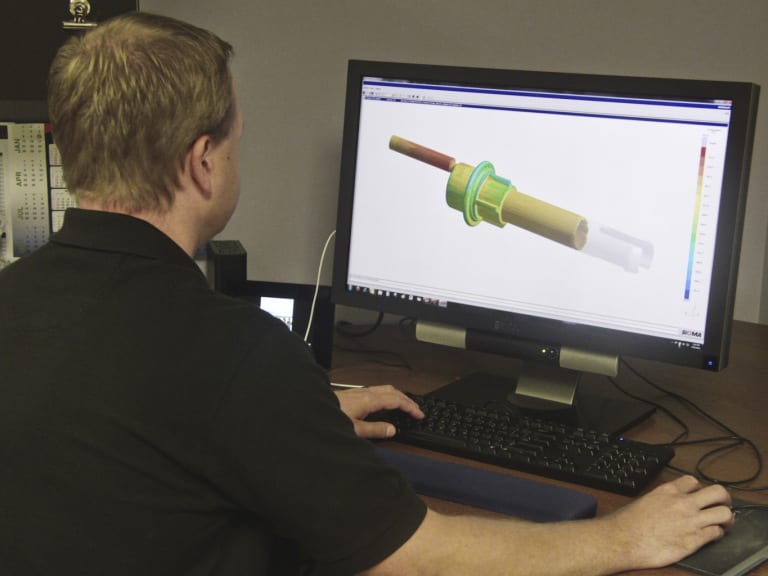
Stafford Frearson, Project Engineer at Tessy Plastics, works on a project using SIGMASOFT at Tessy Plastics in Elbridge, NY.
Servicing the medical, consumer products, business machines, electronic and packaging markets, Tessy partners with their customers from the design stage all the way through product completion. Enabling them to provide their customers a full service experience, Tessy offers additional services including ultrasonic, vibration or laser welding, hot stamp/hot decal, pad printing, laser engraving, or label application printing, manual, semi-automated, fully automated or cleanroom assembly. Finishing options include gluing/bonding, machining/drilling, contact insertion, as well as, high-speed fluid dispensing or ultrasonic dispensing. Tessy also provides leak, burst, dielectric, electric, optical, rheological and spectrophotometer testing. As part of their partnership, Tessy holds themselves 100% accountable for quality assurance.
Proud of their “Commitment to Innovation,” Tessy is in constant evolution creating an atmosphere of growth and discovery. Joe Raffa, VP and General Manager in charge of sales, says, “Using our engineering department, our goal is to continually explore and implement new ways to enable our customers to significantly evolve their business in the most cost effective, lean manner .” Tessy is keeping the injection molding process on the cutting edge of technology by having the capability to evaluate the entire process virtually before sample runs are even attempted on the shop floor. Eric Frearson, VP of Engineering, states, “We have some very complex parts that we manufacture as well as complex molds. Acquiring SIGMASOFT® about two years ago to virtually run the entire mold and process before using production time changed the way we do business. This enables us to understand and find solutions to significant problems that, in some cases, we have been working on for a long time,. We are now pointed in the right direction and shown the precise areas we need to focus on to create a solution, thanks to this process optimization software package.”
At Tessy, the members of the sales team have engineering backgrounds while the engineering team is heavily involved in building, developing and maintaining customer relationships. The sales team boasts trying to commit the engineers to projects that are almost impossible while the engineers welcome the challenge and come up with ways to make them happen. Raffa explains, “With SIGMASOFT® onboard, we are able to commit to these almost impossible jobs. I know that when the customer poses new projects to us, I can go to engineering and talk about warp analysis or filling analysis and whether or not a project is even feasible. Once getting that confirmation after running the process virtually, I have the confidence to commit to a project, knowing that the information we received from the simulated run will reflect reality at least 98% of the time.” Matt Learo, Sales Manager, adds, “We had an existing customer where the materials they were using were discontinued. The customer called and requested that their new material and new tool be run through SIGMASOFT® specifically, to see how the new material was going to behave.” Stafford Frearson, Project Engineer expands, “The more complicated a project is and the more complex a configuration might be, when we are not sure how it might warp or how it might fill, there’s no question we feel more confident in going to the customer and saying, ‘this is what you are going to see’, when we have the report backing us up.” “We use other simulation software, but when the part is complex and on our harder jobs, we always run them through SIGMASOFT®,” Eric Frearson adds.
Tessy has used simulation software for over 20 years but feels adding SIGMASOFT® as one of their resources significantly changed the way they do business. Raffa told of a situation that occurred within the first few months after acquiring the new software. Most new projects Tessy acquires are first-time molded products. In most cases, Tessy helps design the part as well as the molds. Normally, all the components in the assembly are new designs. In one particular instance that Raffa described, the customer wanted to take new components and marry them to old components for a different look in the end product. Tessy learned by examining the way some of the wall thicknesses had to be designed and the way the assembly had to come together through simulation that it wasn’t optimal and the new design would simply not work. The parts that were being received from the prototype molds found warp that Tessy had never seen on these types of projects previously. The customer requested a stress and distortion analysis from an engineering company, costing them thousands of dollars, in addition to taking considerable time. Although the engineering company did provide some results and recommendations, the evidence to support these recommendations was not provided.
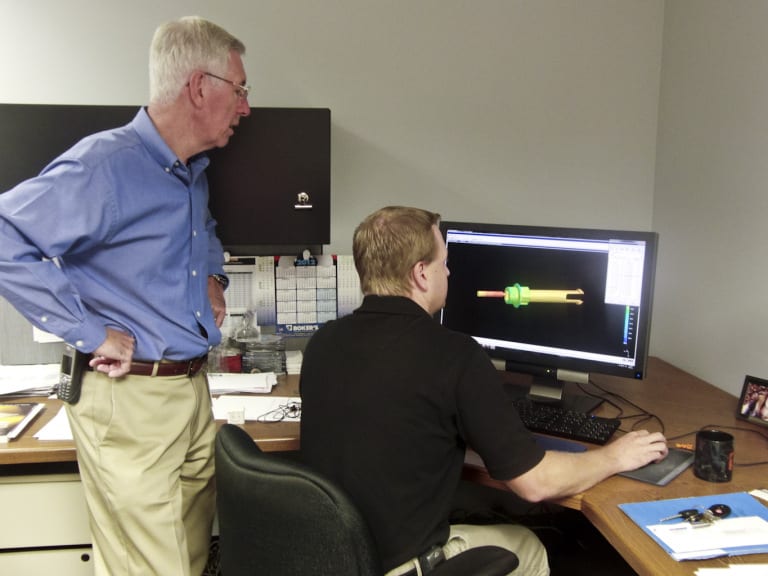
Eric Frearson, Vice President of Engineering, Tessy Plastic (Left) and Stafford Frearson, Project Engineer at Tessy Plastics, discuss a SIGMASOFT screen at Tessy Plastics in Elbridge, NY.
This became the first large project on which Tessy used SIGMASOFT®. By running multiple processes and cooling times and looking at iterations even 24-48 hours later to see how the part was going to react, it was clearly seen when pulling up snapshots and data during certain points through the process what the issue was. Tessy was able to see the part, how it cooled outside of the mold, how it flexed and how it actually got to the state where it was warped. Eric Frearson said, “It gave us evidence to show the customer that no amount of cooling changes or process changes had any effect on the problem. It was purely a design change that was needed to fix the problem. The reports provided by the software gave us the credibility and the client the reassurance to make the changes.” Raffa adds, “It essentially short cut the entire process, we didn’t try running DOEs of all different configurations or measured a ton more parts to chase something that was really not the solution.” Learo also states, “What’s reassuring about this situation was that we hadn’t used SIGMASOFT® for very long at this point and the customer was willing to pay for the stress and distortion analysis from the engineering company and see how the results compared. We found the results long before the engineering company did. When we did receive their findings, they were the same. The difference was, we were able to show why it happened and already had a solution to present our customer.” Eric Frearson adds, “Even the engineer running the analysis at the independent company was impressed. He is an experienced analyst who regularly uses a different product.”
Tessy uses virtual scientific injection molding almost exclusively, enabling their customers to save time, material and money by doing virtual studies in order to predict molding parameters. The addition of this valuable tool enables them to focus on what the final process would be. “We can now say with a very high degree of certainty what the cycle times will be and what issues we might have, before manufacturing ever sees the tool. We weren’t able to say that before having SIGMASOFT®,” Raffa said. Tessy also sees an impact of the software on manufacturing, by helping validate the process before a mold is cut. Learo adds, “We are able to give the process technicians better process parameters before we even see the mold.”
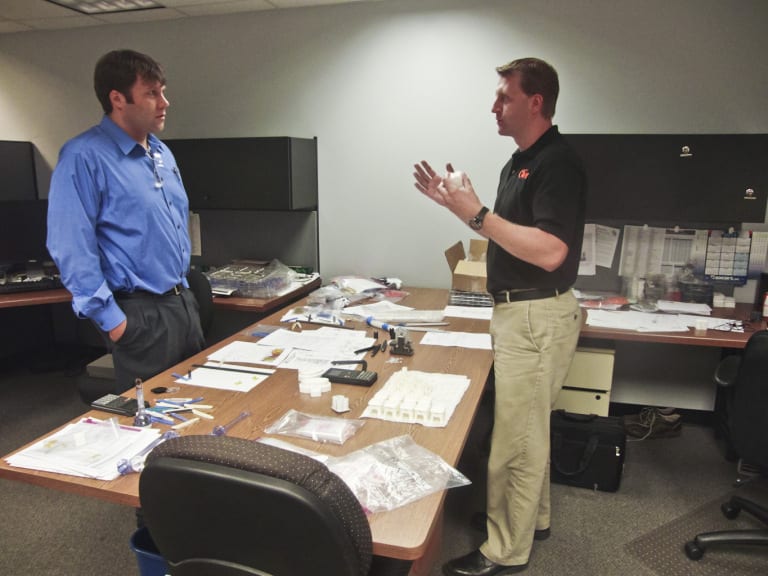
Matt Proske, Vice President, SIGMA Plastic Services (Left) and Stafford Frearson, Project Engineer at Tessy Plastics, have a conversation at Tessy Plastics in Elbridge, NY.
Giving credit to their “Commitment to Innovation,” Tessy is experiencing record growth and expansion in their business, even in these unstable economic times. The implementation of innovative technologies continues to not only ensure profitability, but also contributes to its employees’ ability to further their careers, providing opportunities for advancement on multiple levels. Being part of an industry that is constantly evolving, the leadership at Tessy keeps encouraging their team to reach the highest standards and quality deliverables, which in the market drives all plastic molders to move forward and continue to reach out for new and more efficient ways of serving their customers. It is Tessy’s goal to strive for the most cost-effective, time-saving solutions to ensure quality products for its partners.
For more information, contact:
Matt Proske
Vice President
SIGMA Plastic Services, Inc.
10 N. Martingale Road, Suite 425
Schaumburg, IL 60173
Phone: 847-558-5602
Email: contact@3dsigma.com
Web: www.3dsigma.com
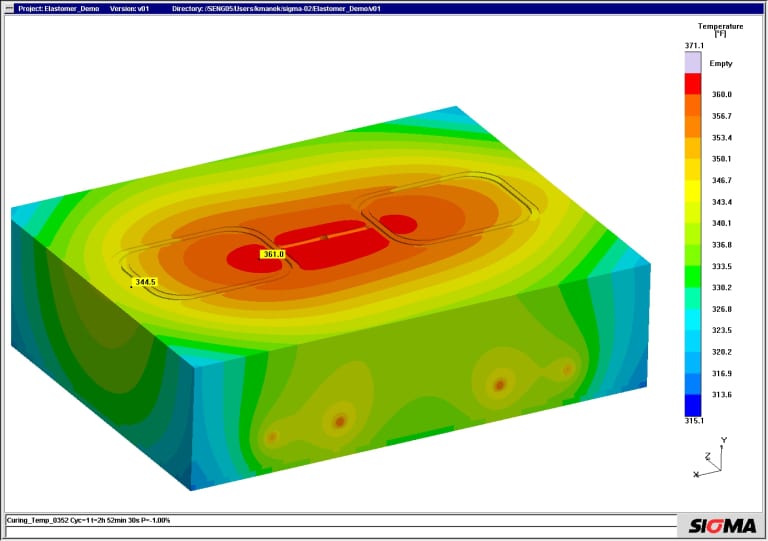 SIGMA Plastic Services will partner with RJG to provide a detailed training session to educate plastic injection molding professionals on cutting edge technologies that will assist in more successful product launches.
SIGMA Plastic Services will partner with RJG to provide a detailed training session to educate plastic injection molding professionals on cutting edge technologies that will assist in more successful product launches.
Working together with RJG at the Medical Devices conference, the goal is to provide attendees with a demonstration on how to utilize currently available technology to their best advantage. Reducing time to market with higher quality and repeatable molding processes are key to the future success of injection molding professionals and OEM’s.
RJG and SIGMA will take you through the critical steps from product design to production with best practices for successful, profitable molding. Develop and merge the part design, the polymer, the mold, and the process in a virtual production environment where all of the critical aspects related to profitable part quality can be evaluated and optimized before the actual mold is ever built.
This is an actual workshop with worksheets and exercises that can be used to develop improved communications within your work environment.
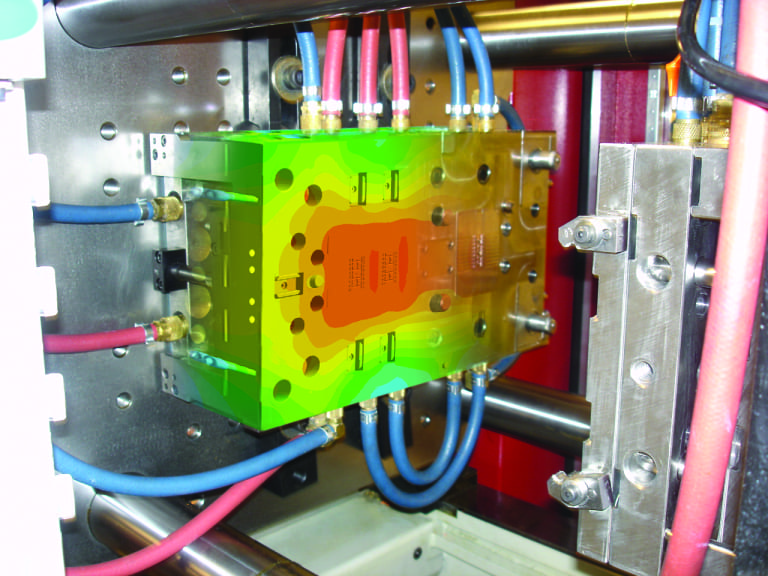 What areas of the part design are the most critical?
What areas of the part design are the most critical?
Should the mold insert be P20, H13, or a Cu based alloy?
Where are the most critical areas for cooling?
What will the cycle time be?
Is the distortion related to fiber orientation or temperature?
Can it be controlled with packing?
Will it be pressure limited when the viscosity shifts?
How big is the process window?
Can the process be maintained?
Where do we need sensors?
How to contain parts produces outside of the process window
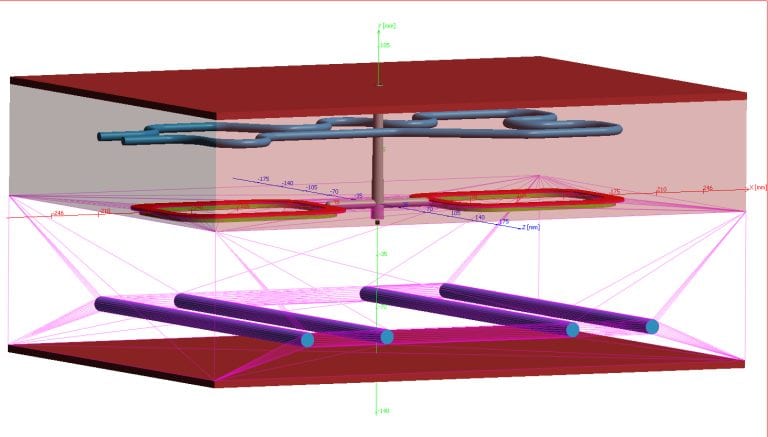 Virtually develop and optimize the mold and the process together, before the mold is ever built. Verify the appropriate molding machines are capable and available. Ensure the best process is developed, used and repeated, in spite of day to day variation in the production environment.
Virtually develop and optimize the mold and the process together, before the mold is ever built. Verify the appropriate molding machines are capable and available. Ensure the best process is developed, used and repeated, in spite of day to day variation in the production environment.
If the mold is already built and the part dimensions from the quoted 30s cycle are out of spec, what are you going to do about it, other than lose money…..? There are more profitable ways of doing things.
For more information, contact:
Matt Proske
Vice President
SIGMA Plastic Services, Inc.
10 N. Martingale Road, Suite 425
Schaumburg, IL 60173
Phone 847-558-5602
Email contact@3dsigma.com
Web www.3dsigma.com
Using the process-oriented approach of SIGMASOFT® makes it possible to consider all of the molding times present in an actual injection molding cycle. In the injection molding simulation of elastomeric applications, SIGMASOFT® not only considers the filling and curing times, but also the non-productive times between each production cycle while the mold is opened and closed. If the simulated process considers the influence of multiple consecutive molding cycles, the accuracy of the simulation is dramatically improved.

Figure 1 – Temperature distribution in a metallic component over-molded with rubber. Left: without consideration of the mold opening time; right: considering a mold opening time of 60 seconds, where significantly lower temperatures and long curing times are observed.
Even though it is not necessary to include them to complete an injection molding simulation, the “non-productive” times have a major influence on the mold temperature and thus on the process and on the part quality. With the Process Simulation Software SIGMASOFT®, from SIGMA Plastic Services, Inc. (Schaumburg, Illinois), all the non-productive times can also be included into the simulation of multiple consecutive production cycles and a substantial improvement in the accuracy of the results predicted can be achieved.
Considering the times in which the mold opens and closes, the times in which the mold is heated or cleaned, as well as handling times in which the inserts are placed or the parts removed, makes it possible to exactly describe the real multi-cycle production process. The interaction between all components present in the mold is considered with the local temperature dependent material properties, along with the heat that escapes the mold into the environment while it is both opened and closed and the exact timing of each event are coupled together inside of SIGMASOFT® to provide a comprehensive understanding of a very complex system. In this way, even factors that influence the part quality, such as the mold temperature and curing degree, can be predicted before the mold is ever built.
An example is presented in Figure 1. In this case, the mold temperature drops significantly while it is in the open position because heat radiates from both heated mold surfaces. If this time and open condition are not considered in the simulation, the mold temperature calculation will be higher than actual; resulting in a faster curing reaction and a shorter cycle time than what is actually possible. Other events will also be incorrectly calculated such as curing degree during filling and required injection pressure.
In SIGMASOFT®, non-productive times can be defined and individually modified in the simulation. For this reason, it is also possible to optimize the entire production process or mold design simultaneously. Through this simulation, it is possible to decide if changes in the process definition will solve production problems, or if the mold has to be modified to achieve the desired quality and productivity goals.
For more information:
Matt Proske
SIGMA Plastic Services, Inc.
10 N. Martingale Road, Suite 425
Schaumburg, IL 60173
Phone: 847-558-5600
Email: contact@3dsigma.com
Web: www.3dsigma.com
—
SIGMA® (www.3dsigma.com) is 100% owned by MAGMA® (www.magmasoft.com), the world market leader in casting process simulation technology based in Aachen, Germany. Our SIGMASOFT® process simulation solution optimizes the manufacturing process for injection molded plastic, thermoset, rubber, and MIM/CIM components. SIGMASOFT® combines the 3D geometry of the parts and runners with the complete mold assembly and temperature control system and incorporates the actual production process to develop a turnkey injection mold with an optimized process.
At SIGMA® and MAGMA®, our goal is to help our customers achieve required part quality during the first trial. The two product lines – injection molded polymers and metal castings – share the same 3D simulation technologies focused on the simultaneous optimization of design and process. SIGMASOFT® thus includes a variety of process-specific models and 3D simulation methods developed, validated and constantly improved for over 25 years. A process-driven simulation tool, SIGMASOFT®, with its comprehensive simulation approach, provides a tremendous benefit to production facilities. Imagine your business when every mold you build produces required quality the first time, every time. That is our goal. This technology cannot be compared to any other conventional “design” simulation approach employed in plastics injection molding.
New product success requires a different communication between designs, materials, and processes that design simulation is not meant for. SIGMASOFT® provides this communication. SIGMA® support engineers, with 450 years of combined technical education and practical experience, can support your engineering goals with applications specific solutions. SIGMA® offers direct sales, engineering, training, implementation, and support, by plastics engineers worldwide.
Continue readingWith the process-oriented approach of SIGMASOFT®, the injection molding simulation for elastomers is no longer limited to predicting the cavity filling while designing the part, or to answering questions regarding balanced filling. Based on an accurate simulation of the curing reaction (vulcanization), it can be used for designing the mold, identifying process windows and troubleshooting during production.
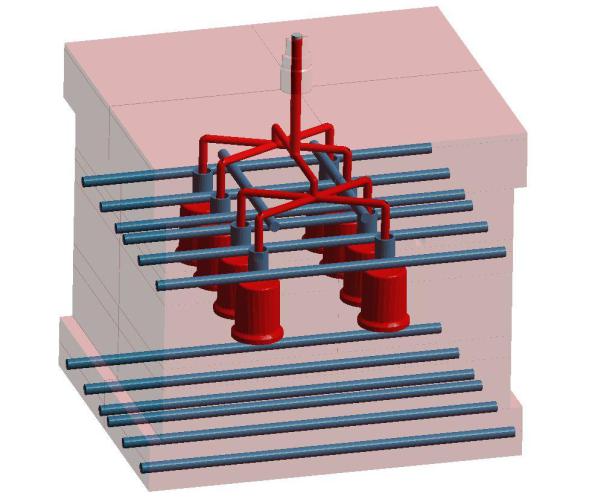
Figure 1 – The process-oriented approach of the Injection Molding Simulation Software SIGMASOFT® allows all relevant information (Part, Insert, Venting, Material, Mold, Heaters, Thermocouples, Process, etc.) to be used in the calculations.
SIGMA Plastic Services, Inc., Schaumburg, IL presents the latest functionality of its 3D Injection Molding Simulation Software SIGMASOFT®. The focus is on reduction of development and production costs using these new developments in process simulation.
Many factors in elastomer injection molding have an influence on product quality and costs. Here it is of little help to solely focus on a single aspect; part design, material, mold design, or molding process. To ensure a competitive advantage, the entire system must be considered simultaneously. Only when everything is optimized during the design phase, before the mold is shipped, can the largest cost savings be achieved.
By means of process simulation, molding feasibility and initial process parameters can be evaluated. Parting line and venting channels can be developed, as well as the optimal type and position of the injection point. Where are weld-lines acceptable, where must they be avoided? How much injection pressure will be required? Ultimately, the complete mold and process must be optimized. What wattage and heater design is most beneficial? Where is the best thermocouple location for each heater? Do inserts need pre-heating and how will they influence the curing? How long is the curing cycle, what areas of the part cure late and why? These questions are all related to the mold design and the production process and they are all important factors regarding part quality.
The simulation results provide answers to all of these questions in a clear and meaningful way, allowing injection molders a way to virtually test the mold before it is built. Costs can be reduced significantly during development, and existing processes can continuously be improved, while substantially reducing material waste and improving quality.
The latest developments in the thermal solver allow for the integration of all mold components and their individual temperature dependent material properties. In this way, an accurate reproduction of the real temperature profile in the mold is possible, even over several consecutive injection molding cycles. The simulation set-up is optimized for the requirements of process engineers. This allows production-minded engineers to use this technology without a simulation background. For example, a process engineer can determine how heating cartridges influence mold temperature and part quality, simulating them with their respective electric power and thermocouple control.
For more information:
Christof Heisser or Matt Proske
SIGMA Plastic Services, Inc.
10 N. Martingale Road, Suite 425
Schaumburg, IL 60173
Phone: 847-558-5600
Email: contact@3dsigma.com
Web: www.3dsigma.com
—
SIGMA® (www.3dsigma.com) is 100% owned by MAGMA® (www.magmasoft.com), the world market leader in casting process simulation technology based in Aachen, Germany. Our SIGMASOFT® process simulation solution optimizes the manufacturing process for injection molded plastic, thermoset, rubber, and MIM/CIM components. SIGMASOFT® combines the 3D geometry of the parts and runners with the complete mold assembly and temperature control system and incorporates the actual production process to develop a turnkey injection mold with an optimized process.
At SIGMA® and MAGMA®, our goal is to help our customers achieve required part quality during the first trial. The two product lines – injection molded polymers and metal castings – share the same 3D simulation technologies focused on the simultaneous optimization of design and process. SIGMASOFT® thus includes a variety of process-specific models and 3D simulation methods developed, validated and constantly improved for over 25 years. A process-driven simulation tool, SIGMASOFT®, with its comprehensive simulation approach, provides a tremendous benefit to production facilities. Imagine your business when every mold you build produces required quality the first time, every time. That is our goal. This technology cannot be compared to any other conventional “design” simulation approach employed in plastics injection molding.
New product success requires a different communication between designs, materials, and processes that design simulation is not meant for. SIGMASOFT® provides this communication. SIGMA® support engineers, with 450 years of combined technical education and practical experience, can support your engineering goals with applications specific solutions. SIGMA® offers direct sales, engineering, training, implementation, and support, by plastics engineers worldwide.
Continue readingBesides predicting the filling process, the process simulation software SIGMASOFT® can also predict the curing reaction of elastomers and the thermal performance of mold tempering systems. A major advantage is that not only the cavity is simulated, but the complete mold including all details is considered in the calculation. Therefore, the interaction between heating elements, elastomer, inserts and mold can be accurately predicted.
 Schaumburg, September 7, 2012 – In the elastomer processing industry, it is common for companies to rely on trial-and-error methods to solve production problems. Without process simulation, operators suggest a mold configuration which “should work” for a specific part geometry, based on experience. Factors such as tempering or processing times are defined later during the first production trials. It is not uncommon to find molds which require several rework stages, as well as parts with quality issues where the causes for this issues are not well understood.
Schaumburg, September 7, 2012 – In the elastomer processing industry, it is common for companies to rely on trial-and-error methods to solve production problems. Without process simulation, operators suggest a mold configuration which “should work” for a specific part geometry, based on experience. Factors such as tempering or processing times are defined later during the first production trials. It is not uncommon to find molds which require several rework stages, as well as parts with quality issues where the causes for this issues are not well understood.
Simulation technology can help avoid all these typical processing problems while saving significant time and effort during the development of a new mold. When utilizing the approach of “Process Simulation”, provided by SIGMA® with its software SIGMASOFT®, all the elements of the mold can be included. This allows the molder to run a “virtual production”, including all the process stages (preheating of the mold, injection, curing), not only over one cycle, but over several production cycles. With this process, the performance of a mold design can be evaluated completely before the steel is even cut.
“Historically, elastomer molders have relied on conventional injection molding tools to predict the filling of the cavity. Many processors still think this is all simulation can do for them. However, simulation tools available nowadays are far more powerful. Besides filling, the curing reaction can be accurately predicted, and the thermal behavior can be exactly anticipated”, explains Dr. Marco Thornagel, executive director of SIGMA Engineering GmbH/Germany. “Simulation can make a company achieve its production goals faster, being more profitable”.
Simulation can analyze different variables of the design of a new mold. After determining the desired geometry, the process starts with the selection of the injection point or gate type. Understanding the flow behavior, as well as quality issues related to weld lines, air gaps or jetting, the runner geometry can be defined. In this stage, different aspects including cavity balance or the pressure requirement can be predicted.
Once the part and runner are defined, the tempering of the mold can be designed. In the simulation the tempering elements can be precisely included: it is possible to define their exact location in the mold, as well as the material and the electric power. Even the control system can be defined. Instead of assuming a mold temperature in the simulation, the exact thermal condition of the mold is predicted, including the way it fluctuates over time.
After the effect of the desired tempering system is simulated, factors in the mold which can compromise part quality can be identified. Cold spots in the mold where the material cures too late or irregular temperature distributions, which can produce different curing degrees for parts produced in different cavities, are some examples of the virtual “troubleshooting” that can be achieved with Process Simulation.
For more information:
Christof Heisser or Matt Proske
SIGMA Plastic Services, Inc.
10 N. Martingale Road, Suite 425
Schaumburg, IL 60173
Phone: 847-558-5600
Email: contact@3dsigma.com
Web: www.3dsigma.com
Continue readingThe process-oriented approach of SIGMASOFT® makes it possible to use injection molding simulation of elastomer applications not only for filling or cooling times, but also the non-productive times between each process phase. When the process is simulated considering the influence of operational times occurring between the main process stages, the accuracy of the simulation is dramatically improved.
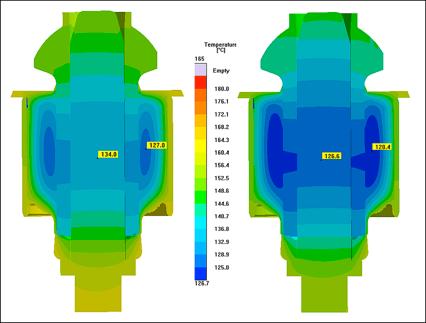
Temperature distribution in a metallic component overmolded with elastomer. Left: without consideration of the mold opening time; right: considering a mold opening time of 60s.
Schaumburg, IL, September 7, 2012 – Even though it is not necessary to include them to complete an injection molding simulation, the non-productive times have a major influence on the process and on part quality. Process Simulation Software SIGMASOFT®, from SIGMA®, can include non-productive times in the simulation enabling substantial improvement in the accuracy of the results to be achieved.
Taking into consideration the times in which the mold opens and closes, the times in which it is heated up or cleaned, as well as handling times when the inserts are placed simulation makes it possible to accurately analyze the process cycle. The interaction between all mold components has to be considered and cycle times have to be predicted accurately. That way even factors that influence the part quality, such as the curing degree, can be predicted by the simulation.
An example is presented in Figure 1. In this case the mold temperature decreases during the time period when the mold stays open. If this time is not considered in the simulation, the prediction of the whole cycle time, as well as the prediction of the cooling time or curing degree, will be erroneous. Besides, the predicted quality of the parts produced can deviate from reality.
In SIGMASOFT®, such non-productive times can be defined and varied separately in the simulation. Therefore, besides calculating the whole cycle, it is also possible to perform trouble-shooting of problems at each of the production stages. Through the utilization of simulation it is possible to decide if changes in the process definition are enough to solve production problems, or if the mold has to be reworked to achieve the desired quality and productivity goals.
—
SIGMA® (www.sigmasoft.de) is 100% owned by MAGMA® (www.magmasoft.de), the world market leader in casting process simulation technology based in Aachen, Germany. Our SIGMASOFT® process simulation solution optimizes the manufacturing process for injection molded plastic components. SIGMASOFT® combines the 3D geometry of the parts and runners with the complete mold assembly and temperature control system and incorporates the actual production process to develop a turnkey injection mold with an optimized process.
At SIGMA® and MAGMA®, our goal is to help our customers achieve required part quality during the first trial. The two product lines – injection molded polymers and metal castings – share the same 3D simulation technologies focused on the simultaneous optimization of design and process. SIGMASOFT® thus includes a variety of process-specific models and 3D simulation methods developed, validated and constantly improved for over 25 years. A process-driven simulation tool, SIGMASOFT®, with its comprehensive simulation approach, provides a tremendous benefit to production facilities. Imagine your business when every mold you build produces required quality the first time, every time. That is our goal. This technology cannot be compared to any other conventional “Design” simulation approach employed in plastics injection molding.
New product success requires a different communication between designs, materials, and processes that design simulation is not meant for. SIGMASOFT® provides this communication. SIGMA® support engineers, with 450 years of combined technical education and practical experience, can support your engineering goals with applications specific solutions. SIGMA® offers direct sales, engineering, training, implementation, and support, by plastics engineers worldwide.
For more information:
Christof Heisser or Matt Proske
SIGMA Plastic Services, Inc.
10 N. Martingale Road, Suite 425
Schaumburg, IL 60173
Phone: 847-558-5600
Email: contact@3dsigma.com
Web: www.3dsigma.com
Continue readingWith the process-oriented approach of SIGMASOFT®, the injection molding simulation for elastomers is no longer limited to predicting the cavity filling while designing the part or to answer questions regarding a balanced filling. Based on an accurate simulation of the curing reaction (vulcanization), it can be used for designing the mold, identifying process windows and troubleshooting during production.

The process-oriented approach of the Injection Molding Simulation Software SIGMASOFT® allows for the easy and exact consideration of all relevant information regarding mold and process into the calculation, beyond the part and runner geometry.
Schaumburg, IL, July 25, 2012 – At the recent DKT Conference in Nuremburg, Germany, SIGMA Engineering GmbH, Aachen, presented the latest functionality expansions of its 3D Injection Molding Simulation Software SIGMASOFT®. The focus of the presentation was the software’s ability to reduce development and production costs through new developments in process simulation.
Many factors in elastomer injection molding have an influence on product quality and costs. To ensure a competitive advantage, the whole manufacturing process must be considered. Since the design stage has the largest influence over the total costs of a part, this is where the savings start with SIGMASOFT®.
By using process simulation, feasibility and rough process parameters can be evaluated. Parting line and venting channels can be worked out, as well as the optimal type and positioning of the injection drop point. Where are weld-lines acceptable? Where do they need to be avoided? Do inserts need pre-heating? Which level of vulcanization should be reached and how much time and what temperature are needed to achieve this level? Important factors regarding part quality are optimized in this way, through the algorithms in the software.
A mold, which will be used for producing the part, can now be developed. Decisions must be made at this point, which can incur substantial costs: How many cavities can be designed in the mold (clamping force and required pressure)? How should the runner system be designed to obtain balanced cavity filling and the same compound quality in every cavity? Is there need for a cold runner? What heat-output is needed and how must the heating system be configured? Are the heated clamping plates adequate? Where should control points for the tempering be positioned?
The simulation is able to answer all these questions and allows reaching the desired quality with minimal effort (time and energy). In this way, the process stability is guaranteed before the mold is even built. Costs can be reduced significantly during development and existing processes can continue to be improved. This is all accomplished while substantially reducing rejects and material waste, thereby getting to the first good part much faster.
The latest developments in the software’s thermal solver allows for the exact integration of all mold components. As a result, an accurate reproduction of the real temperature profile in the mold is possible, even over multiple injection molding cycles. The simulation definition is optimized for the requirements of process engineers, so that complex detail questions can be examined from a practical perspective without requiring extensive knowledge of simulation software. For example, it can be determined how heating cartridges influence mold temperature and part quality, simulating them with their respective electric power and control.
—
SIGMA® (www.sigmasoft.de) is 100% owned by MAGMA® (www.magmasoft.de), the world market leader in casting process simulation technology based in Aachen, Germany. Our SIGMASOFT® process simulation solution optimizes the manufacturing process for injection molded plastic components. SIGMASOFT® combines the 3D geometry of the parts and runners with the complete mold assembly and temperature control system and incorporates the actual production process to develop a turnkey injection mold with an optimized process.
At SIGMA® and MAGMA®, our goal is to help our customers achieve required part quality during the first trial. The two product lines – injection molded polymers and metal castings – share the same 3D simulation technologies focused on the simultaneous optimization of design and process. SIGMASOFT® thus includes a variety of process-specific models and 3D simulation methods developed, validated and constantly improved for over 25 years. A process-driven simulation tool, SIGMASOFT®, with its comprehensive simulation approach, provides a tremendous benefit to production facilities. Imagine your business when every mold you build produces required quality the first time, every time. That is our goal. This technology cannot be compared to any other conventional “Design” simulation approach employed in plastics injection molding.
New product success requires a different communication between designs, materials, and processes that design simulation is not meant for. SIGMASOFT® provides this communication. SIGMA® support engineers, with 450 years of combined technical education and practical experience, can support your engineering goals with applications specific solutions. SIGMA® offers direct sales, engineering, training, implementation, and support, by plastics engineers worldwide.
For more information:
Christof Heisser or Matt Proske
SIGMA Plastic Services, Inc.
10 N. Martingale Road, Suite 425
Schaumburg, IL 60173
Phone: 847-558-5600
Email: contact@3dsigma.com
Web: www.3dsigma.com
Continue readingThanks to a completely reengineered solver technology and a revolutionary meshing concept, with SIGMASOFT® Version 5.0, the simulation time required in elastomer applications can be reduced by up to 80%. With this dramatic speed-up, simulation can now be integrated in the elastomer processing on a daily-basis, both for part design and process troubleshooting.
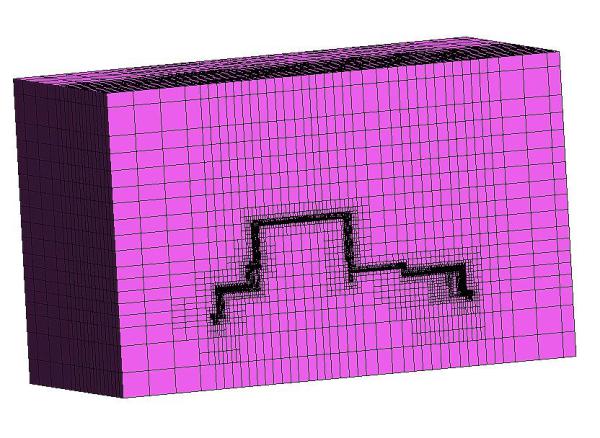
Figure 1 –With the new solver technology and the use of “unstructured meshes,” SIGMASOFT® Version 5.0 reduces the calculation time by up to 80% in the simulation of elastomer injection applications.
Schaumburg, IL, July 25, 2012 – At the DKT conference in Nuremberg, Sigma Engineering GmbH, Aachen, presented SIGMASOFT® Version 5.0, the latest release of its process-oriented simulation software. With a completely reengineered solver technology and a new meshing concept, calculation times have been dramatically reduced, while keeping all the advantages of accuracy and user friendliness of a complete 3D-simulation approach.
“With SIGMASOFT® Version 5.0, we have achieved a major breakthrough in injection molding simulation,” explains Dr. Marco Thornagel, Executive Manager at Sigma. “Some years ago, users had to wait sometimes days to get the results of a simulation. It was not viable to use simulation to support every-day production activities, or to quickly optimize products. Now, however, simulation can be part of the daily production tools used in the mold shop or in the production floor, to deliver reliable and profitable answers both to design new products and to optimize existing molds.”
SIGMASOFT® is still the only option available in the market to seamlessly integrate all elements in the mold within the simulation. Thanks to the implementation of “Finite Volume” numerical methods, not only can the cavity be considered in the simulation, but also the complete real mold configuration, including tempering channels, heating elements and inserts. SIGMASOFT® is and has always been based exclusively in 3D technology, developed over a quarter century. The mesh required to conduct the simulation is generated effortlessly by the user in only minutes, without requiring any manual optimization.
The new meshing technique in the latest version of the software uses “unstructured meshes.” These are basically “intelligent meshes,” which can automatically mesh finer regions where complex thermal and flow phenomena take place, such as part boundaries, thin walls or complex runner systems. It also can save mesh elements in regions where fewer interactions take place, such as mold boundaries. The calculation effort is reduced and the productivity of the software increases.
Through parallelization, the new solver architecture makes it possible to exploit the complete potential of multi-core technology in state-of-the-technology computers. Beyond a significant reduction in computational time, the technology now allows users to simulate more complicated injection molding processes. This will be now the focus of further developments in the software, according to Sigma sources.
For further information on this story, please contact:
Matt Proske
SIGMA Plastic Services, Inc.
10 N. Martingale Road, Suite 425
Schaumburg, IL 60173
Phone: 847-558-5600
Email: contact@3dsigma.com
Web: www.3dsigma.com
Continue reading
Using a completely 3D-approach and the integration of a highly developed thermal solver, the injection molding simulation software SIGMASOFT® allows the calculation of multiple consecutive production cycles, considering the thermal interactions throughout all the components in the mold. The accuracy of the entire simulation is thus dramatically increased.

Figure 1 – The multi-cycle analysis of SIGMASOFT® allows simulating the heat transfer in the mold from start-up over multiple production cycles, and thus exactly reproduces the real production conditions in the cavity. Left: Temperature distribution in a half of the mold cavity after one cycle. Right: Temperature distribution after 15 cycles.
Schaumburg, Illinois – SIGMA® Plastic Services presented its SIGMASOFT® software designed for 3D injection molding process simulation at the recent Euromold 2011, hall 8, stand A 101. One of the highlights of the presentation was the SIGMASOFT® unique functionality of its “multi-cycle analysis”, a new benchmark in injection molding simulation.
“In conventional injection molding software, a fixed mold temperature is defined and the whole simulation is carried out under the assumption that this value remains constant over time”, explained Dr. Marco Thornagel, Executive Director of SIGMA® Engineering. “In reality, however, you have a very complex thermal process taking place within the mold: the steel is cooled with a tempering system, the mold is heated when the hot polymer melt enters the cavity and there is a loss of thermal energy towards the surrounding environment. All governed by the heat transfer properties of the materials present throughout the system: polymer melt, runner system, inserts, mold, isolation materials. Only when these complex interactions are considered will the real production conditions be reproduced in the simulation. And our customers really appreciate that we already have 25 years of experience in how to make this kind of simulation, with a user friendly meshing algorithm,” observed Dr. Thornagel.
The 3D-approach of SIGMASOFT® allows all the components in a mold, including all the thermal and physical properties of each one of them, to be exactly reproduced. Therefore, the heat transfer process can be accurately calculated between each one of the components.
To accurately simulate the production conditions, the heat transfer process taking place in reality must be exactly reproduced in the simulation. This includes the heat-up during the start-up of the machine, when the mold is heated from room temperature to its production conditions (typically between 60º and 120°C) by the tempering system. It also includes the warming up produced by the hot polymer melt over several consecutive pre-production cycles, as happens in actual run conditions.
SIGMASOFT® is able to exactly reproduce the heat-up stage, as well as simulate the thermal evolution of the mold over multiple consecutive production cycles. This accurate calculation predicts the real temperature in each location of the mold during production, producing a condition that more closely reflects reality for the polymer as it sets inside the cavity. This allows the software, for example, to predict how long the polymer remains in a fluid condition so that post-pressure can be applied, or where will the thermally induced deformation most likely compromise the part quality.
Another of the advantages of multi-cycle simulation is the possibility to calculate how many production cycles are required for the mold to achieve cyclic equilibrium – and thus consistent quality conditions over a production run. Therefore, the number of parts required before the actual production begins can be more accurately predicted. The system can be optimized to minimize the number of pre-production parts that are required. Another possibility is to compare the efficiency of different tempering systems to understand how to achieve equilibrium more quickly or how to consume less energy.
SIGMA® (www.sigmasoft.de) is 100% owned by MAGMA® (www.magmasoft.de), the world market leader in casting process simulation technology based in Aachen, Germany. Our SIGMASOFT® process simulation solution optimizes the manufacturing process for injection molded plastic components. SIGMASOFT® combines the 3D geometry of the parts and runners with the complete mold assembly and temperature control system and incorporates the actual production process to develop a turnkey injection mold with an optimized process.
At SIGMA® and MAGMA®, our goal is to help our customers achieve required part quality during the first trial. The two product lines – injection molded polymers and metal castings – share the same 3D simulation technologies focused on the simultaneous optimization of design and process. SIGMASOFT® thus includes a variety of process-specific models and 3D simulation methods developed, validated and constantly improved for over 25 years. A process-driven simulation tool, SIGMASOFT®, with its comprehensive simulation approach, provides a tremendous benefit to production facilities. Imagine your business when every mold you build produces required quality the first time, every time. That is our goal. This technology cannot be compared to any other conventional “Design” simulation approach employed in plastics injection molding.
New product success requires a different communication between designs, materials, and processes that design simulation is not meant for. SIGMASOFT® provides this communication. SIGMA® support engineers, with 450 years of combined technical education and practical experience, can support your engineering goals with applications specific solutions. SIGMA® offers direct sales, engineering, training, implementation, and support, by plastics engineers worldwide.
For further information on this announcement, interested parties should contact:
Christof Heisser or Matt Proske
SIGMA Plastic Services, Inc.
10 N. Martingale Road, Suite 425
Schaumburg, Illinois 60173
USA
Phone: +1 847 558 5600
Email: cheisser@3dsigma.com or mproske@3dsigma.com
Web: www.3dsigma.com
Agency contact for SIGMA:
Wendy McCormick
Bernard & Company
Palatine, Illinois (Chicago)
USA
+1 847 934 4500
With aid of the interface SIGMALINK®, the weld lines predicted with the injection molding simulation software SIGMASOFT® can now be mapped into Finite Element Analysis Software and be considered in the structural design of injection molded parts

The tracer technology in SIGMASOFT® allows visualizing the fully 3D profile of weld lines over the part thickness. With SIGMALINK this information can now be mapped into structural FEA.
Schaumburg, IL – Sigma Plastic Services, presents a new functionality of its injection molding simulation software SIGMASOFT®. The simulation of the cavity filling in injection molding allows identifying regions where weld lines are formed, not only on the surface but also through the part’s thickness, with a completely 3D approach. With the interface SIGMALINK® it is now possible to transfer this 3D information into FEA (Finite Element Analysis) Software, to consider the drop in mechanical properties in these regions when performing structural design. A particular advantage of SIGMASOFT® is the fully 3D prediction of the weld lines, which reproduces the weld regions not only on the surface, but also through the part’s thickness, as it occurs in reality.
Weld lines occur as a consequence of the collision of two (or more) flow fronts in the cavity of a mold. This disruption in the homogeneity of the injection molded part causes optical defects, which compromise the surface quality, but also produces a weakening from the mechanical point of view and, under certain circumstances, weld lines can even act as stress concentrators. Therefore, there is a loss in the mechanical properties in the regions where weld lines appear.
Using the “tracer” technology, which has been available for years in SIGMASOFT®, the appearance of weld lines can be reproduced during the filling stage. The location of the weld lines can be described precisely and an indication is given regarding how critical they are. The formation of the weld lines during the filling stage and the way they flow as the packing pressure is applied are predicted accurately in a 3D approach.
The interface SIGMALINK enables exporting (mapping) physical and flow-related properties into commercial software for FEA (such as Ansys, Abaqus, Radios, etc.). Factors such as flow and thermal induced stresses and fiber orientation can be considered in the FEA. With a further expansion of SIGMALINK® it is now possible to export the information about the final position and 3D profile of the weld lines in the structural FEA. In this way, the drop in the mechanical properties produced by the apparition of weld lines can also be considered in the mechanical part design.
In Figure 1 the formation of a weld line region in SIGMASOFT® is presented. The flow front is depicted in grey. The “tracer” particles in orange show clearly that the melt fronts do not collide in a flat region, but that this weld line has a complex 3D profile at the end of the filling and packaging phases.
SIGMA (www.sigmasoft.de) is 100% owned by MAGMA (www.magmasoft.de), the market leader in casting process simulation technology based in Aachen, Germany. Our SIGMASOFT® process simulation solution optimizes the manufacturing process for injection molded plastic components. SIGMASOFT® combines the 3D geometry of the parts and runners with the complete mold assembly and temperature control system and incorporates the actual production process to develop a turnkey injection mold and optimized process.
At SIGMA and MAGMA, our goal is to help our customers achieve required part quality during the first trial. The two product lines – injection molded polymers and metal castings – share the same 3D simulation technologies focused on the simultaneous optimization of design and process. SIGMASOFT® thus includes a variety of process-specific models and 3D simulation methods developed, validated and constantly improved for over 25 years. A process-driven simulation tool, SIGMASOFT®, with its comprehensive simulation approach, provides a tremendous benefit to production facilities. Imagine your business when every mold you use produces required quality the first time, every time. That is our goal. This technology cannot be compared to any other conventional “Design” simulation approach employed in plastics injection molding.
New product success requires a different communication between designs, materials, and processes that design simulation is not meant for. SIGMASOFT® provides this communication. SIGMA support engineers, with 450 years of combined technical education and practical experience, can support your engineering goals with applications specific solutions. SIGMA offers direct sales, engineering, training, implementation, and support, by plastics engineers worldwide.
For further information on this announcement, interested parties should contact:
Christof Heisser or Matt Proske
SIGMA Plastic Services, Inc.
10 N. Martingale Road, Suite 425
Schaumburg, Illinois 60173
USA
Phone: +1 847 558 5600
Email: cheisser@3dsigma.com or mproske@3dsigma.com
Web: www.3dsigma.com
Agency contact for SIGMA:
Wendy McCormick
Bernard & Company
Palatine, Illinois (Chicago)
USA
+1 847 934 4500
Continue reading